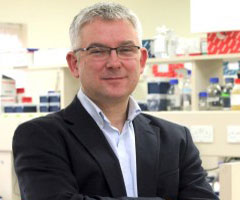Diffuse midline glioma research
Diffuse midline glioma (previously called DIPG) is a type of brain tumour that forms in a part of the brainstem known as the pons. They affect between 20 to 30 children in the UK every year and there is no effective treatment.
Diffuse midline glioma tumours are incredibly difficult to treat as they can’t be be operated on due to their location within the brainstem, a crucial part of the brain that controls vital functions such as breathing.
Our researchers are determined to understand more about this condition and develop new and effective methods to treat it.
Current diffuse midline glioma research projects
Here are the research projects we are currently funding that relate to understanding or treating diffuse midline glioma.

Dr Darren Hargrave
New clinical trials for children with DIPG
Dr Darren Hargrave, a paediatric neuro-oncologist at Great Ormond Street Hospital, is leading a new clinical trial testing three new drugs in 150 children affected by DIPG. This trial will investigate whether each of these new drugs are effective when combined with radiotherapy, whether they can treat the tumour and whether they are well tolerated by patients. The study will be carried out over five years and is being funded in partnership with Cancer Research UK.

Prof. Juan Pedro Martinez-Barbera
Targeting non-dividing cells in childhood high-grade tumours
Current high grade, child brain tumour research projects
Here are some other research projects we are currently funding that relate to understanding or treating high grade child brain tumours including diffuse midline glioma (formerly known as DIPG)

Professor Steve Clifford
INSTINCT – a pioneering research programme for DIPG
Our INSTINCT programme brings together experts from Newcastle University, the Institute of Cancer Research (ICR) and the UCL Institute for Child Health in London to research
high-risk childhood brain tumours, including DIPG.
The research programme on DIPG is being led by Dr Chris Jones at the Institute of Cancer Research. Dr Jones has extensive experience in understanding the genetic basis of these tumours and what is driving tumour growth and then developing new drugs that target the genes involved. In recognition of Dr Jones’ expertise in this field, he is Chair of the European Society of Paediatric Oncology’s group on DIPG and high-grade paediatric brain tumours. As part of the collaborative aims of INSTINCT Dr Jones, with the support of The Brain Tumour Charity, is hosting a closed meeting for some of the world leading experts in DIPG. The aims of the meeting are to combine knowledge and scientific findings from around the world to make faster breakthroughs in DIPG research.

Dr Jan Schuemann
Extreme dose rate proton therapy
Previous studies have shown that delivering radiotherapy extremely rapidly can dramatically reduce side-effects. Radiation therapy that delivers the same dose of radiation in a much shorter period of time is called extreme dose radiation (EDR). EDR therapy has not been tested using proton beams, and that’s where this innovative research project comes in.
The research team, led by Dr Schuemann, will use pre-clinical models to test EDR proton therapy with the aim of establishing a treatment regimen that’s effective and well-tolerated by people. They’ll compare EDR to conventional radiation delivery and look for any differences in side-effects, specifically looking into the effects on cognition and motor control.
Past projects
- Targeting ALK2 in diffuse midline glioma (formerly DIPG)
- Finding new methods to treat diffuse midline glioma
- Investigating tumour initiating events
- The PROMOTE study: Patient Reported Outcome Measures Online To Enhance Communication and Quality of Life after childhood brain tumour
- DAXX – a new target for brain tumour drugs
Working on links with other diseases
Dr Chris Jones and his team at the ICR have previously found a common genetic fault in the DNA of some children with DIPG and the DNA of people with fibrodysplasia ossificans progressive (FOP).
Sometimes called Stone Man Syndrome, FOP causes damaged muscle to turn to bone, so that patients experience increasing immobility and pain as they are gradually ‘locked in’ to a growing skeleton.
Scientists have already discovered that FOP is caused by a fault in the gene ACVR1, which is also found in some diffuse midline glioma patients. Some of the drugs being developed to treat FOP have also shown to be effective in killing tumour cells containing the ACVR1 fault.



